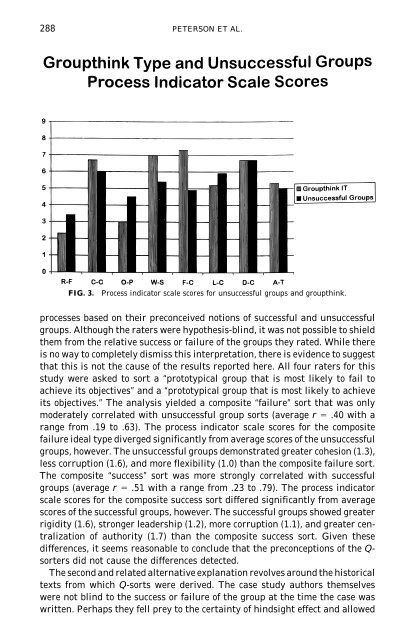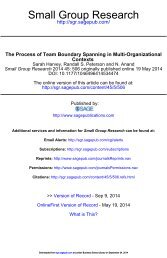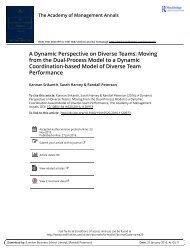Group Dynamics in Top Management Teams: Groupthink, Vigilance, and Alternative Models of Organizational Failure and Success
This study explored the heuristic value of Janis’ (1982) groupthink and vigilant decision making models as explanations of failure and success in top management team decision making using the Organizational Group Dynamics Q-sort (GDQ). Top management teams of seven Fortune 500 companies were examined at two historical junctures—one when the team was successful (defined as satisfying strategic constituencies) and one when the team was unsuccessful. Results strongly supported the notion that a group’s decision making process is systematically related to the outcomes experienced by the team. Ideal-type Q-sorts organized around Janis’ analysis of groupthink and vigilance were substantially correlated with Q-sorts of failing and successful groups, respectively. The fit was, however, far from perfect. Ideal type Q-sorts derived from other frameworks correlated better with the failure–success classification than did the Janis-derived ideal types. Successful groups showed some indicators of groupthink (e.g., risk-taking, cohesion, and strong, opinionated leaders), whereas unsuccessful groups showed signs of vigilance (e.g., internal debate to the point of factionalism). The results illustrate the usefulness of the GDQ for developing and empirically testing theory in organizational behavior from historical cases.
This study explored the heuristic value of Janis’ (1982) groupthink
and vigilant decision making models as explanations of
failure and success in top management team decision making
using the Organizational Group Dynamics Q-sort (GDQ). Top
management teams of seven Fortune 500 companies were examined
at two historical junctures—one when the team was successful
(defined as satisfying strategic constituencies) and one when the team was unsuccessful. Results strongly supported the notion
that a group’s decision making process is systematically related
to the outcomes experienced by the team. Ideal-type Q-sorts organized
around Janis’ analysis of groupthink and vigilance were
substantially correlated with Q-sorts of failing and successful
groups, respectively. The fit was, however, far from perfect. Ideal type
Q-sorts derived from other frameworks correlated better
with the failure–success classification than did the Janis-derived
ideal types. Successful groups showed some indicators of groupthink
(e.g., risk-taking, cohesion, and strong, opinionated leaders),
whereas unsuccessful groups showed signs of vigilance (e.g.,
internal debate to the point of factionalism). The results illustrate
the usefulness of the GDQ for developing and empirically testing
theory in organizational behavior from historical cases.
- No tags were found...
You also want an ePaper? Increase the reach of your titles
YUMPU automatically turns print PDFs into web optimized ePapers that Google loves.
288 PETERSON ET AL.<br />
FIG. 3.<br />
Process <strong>in</strong>dicator scale scores for unsuccessful groups <strong>and</strong> groupth<strong>in</strong>k.<br />
processes based on their preconceived notions <strong>of</strong> successful <strong>and</strong> unsuccessful<br />
groups. Although the raters were hypothesis-bl<strong>in</strong>d, it was not possible to shield<br />
them from the relative success or failure <strong>of</strong> the groups they rated. While there<br />
is no way to completely dismiss this <strong>in</strong>terpretation, there is evidence to suggest<br />
that this is not the cause <strong>of</strong> the results reported here. All four raters for this<br />
study were asked to sort a “prototypical group that is most likely to fail to<br />
achieve its objectives” <strong>and</strong> a “prototypical group that is most likely to achieve<br />
its objectives.” The analysis yielded a composite “failure” sort that was only<br />
moderately correlated with unsuccessful group sorts (average r .40 with a<br />
range from .19 to .63). The process <strong>in</strong>dicator scale scores for the composite<br />
failure ideal type diverged significantly from average scores <strong>of</strong> the unsuccessful<br />
groups, however. The unsuccessful groups demonstrated greater cohesion (1.3),<br />
less corruption (1.6), <strong>and</strong> more flexibility (1.0) than the composite failure sort.<br />
The composite “success” sort was more strongly correlated with successful<br />
groups (average r .51 with a range from .23 to .79). The process <strong>in</strong>dicator<br />
scale scores for the composite success sort differed significantly from average<br />
scores <strong>of</strong> the successful groups, however. The successful groups showed greater<br />
rigidity (1.6), stronger leadership (1.2), more corruption (1.1), <strong>and</strong> greater centralization<br />
<strong>of</strong> authority (1.7) than the composite success sort. Given these<br />
differences, it seems reasonable to conclude that the preconceptions <strong>of</strong> the Q-<br />
sorters did not cause the differences detected.<br />
The second <strong>and</strong> related alternative explanation revolves around the historical<br />
texts from which Q-sorts were derived. The case study authors themselves<br />
were not bl<strong>in</strong>d to the success or failure <strong>of</strong> the group at the time the case was<br />
written. Perhaps they fell prey to the certa<strong>in</strong>ty <strong>of</strong> h<strong>in</strong>dsight effect <strong>and</strong> allowed

















